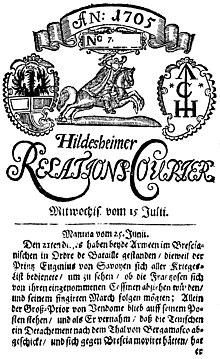Hildesheimer Allgemeine Zeitung
| Hildesheimer Allgemeine Zeitung | |
|---|---|
| description | German daily newspaper |
| publishing company | Gebrüder Gerstenberg GmbH & Co. KG |
| First edition | June 24, 1705 |
| Frequency of publication | Monday to Saturday |
| Sold edition | 32,816 copies |
| ( IVW 2/2020, Mon-Sat) | |
| Editor-in-chief | Martin Schiepanski |
| editor | Daniel Gerstenberg |
| Web link | HAZ website |
The Hildesheimer Allgemeine Zeitung is Hildesheim's only daily newspaper and, founded in 1705, the oldest existing newspaper in Germany. The sold edition is 32,816 copies.
The publisher, Gebrüder Gerstenberg GmbH & Co. KG , holds a 7.3 percent stake in the Madsack publishing group from Hanover (including Hannoversche Allgemeine Zeitung ), which also operates the so-called newspaper cover , i.e. the national politics, business and sports pages delivers and the Hildesheimer Allgemeine Zeitung prints. The SPD is about investments largest limited partner of the publishing group Madsack.
The Hildesheimer Allgemeine Zeitung also has a 24.5 percent stake in the Alfelder Zeitung and a 24 percent stake in the Seesener Beobachter .
history
The Hildesheimer Allgemeine Zeitung is the oldest daily newspaper in Germany. It was a long way from Relations-Courier to HAZ and the history of the newspaper was determined by breaks. There were changes in the newspaper titles, the frequency of publication, the content and the owners.
Founded on June 24, 1705 as Hildesheimer Relations-Courier , it was first renamed in 1775 as Privilegierte Hildesheimische Zeitung . After another renaming to the Royal Prussian most graciously privileged Hildesheim newspaper (1802), the newspaper was discontinued in 1804. The founder was the newspaper correspondent Heinrich Christian Hermitz, who transferred the publishing house to his son-in-law Christian Levin Lüdemann in 1751. At that time, the newspaper did not have any comprehensive reporting, but only dealt with national war events, natural disasters or gossip about rulership. An actual local section was not created until the middle of the 19th century.
After a pause in publication of three years, the HAZ reappeared in 1807 as the Stadt-Hildesheim privileged newspaper and advertisements for all classes . At that time the newspaper was distributed jointly by the holder of the newspaper license, Christian Ludwig Lüdemann, and the bookseller and publisher Johann Daniel Gerstenberg, whereby Gerstenberg alone acted economically and editorially, while Lüdemann only acted as a passive license holder. Gerstenberg, whose descendants still run the publishing house today, was only officially granted the privilege to publish newspapers when Lüdemann died in 1819.
After various other renaming, the newspaper got the name Hildesheimer Allgemeine Zeitung and advertisements for all stands in 1854 , which was shortened to Hildesheimer Allgemeine Zeitung in 1922 . On April 29, 2005, the newspaper celebrated its 300th birthday with a ceremony in the Hildesheim City Theater.
In the 19th and first half of the 20th century, the Hildesheimer Allgemeine Zeitung , unlike today, was not aimed at the whole population, but since the middle of the century primarily at liberal readers and from 1867 primarily at the sympathizers of the National Liberal Party , as theirs Organ the newspaper understood itself and for which the publishers were politically committed. In the Weimar Republic , the paper supported the DVP .
The Hildesheimer Allgemeine Zeitung was - like most of the entire German press - as the official bulletin, firmly integrated into local power structures. There is still no research into the role of the Gerstenbergsche Zeitung in National Socialism. However, it seems clear that the newspaper adopted at least one National Socialist terminology very early on. Unlike many others, the newspaper was not expropriated in the Nazi state (see press in the Nazi state ), but had to accept a reduction in circulation of a third compared to the 1920s. It was not until the late 1930s that the circulation rose again to 11,000 copies, but remained behind the local Nazi daily newspaper Hildesheimer Beobachter , which sold 13,200 newspapers daily.
In 1943 the HAZ was merged with the National Socialist Hildesheimer Beobachter and the Provinzial-Zeitung from Bockenem to form the Hildesheimer Zeitung for economic reasons and continued to appear until the end of the war in 1945. After a forced break (see also post-war press ) of more than four years, the Hildesheimer Allgemeine Zeitung appeared again on October 1, 1949.
Edition
The Hildesheimer Allgemeine Zeitung , like most German newspapers in recent years to rest lost. The number of copies sold has fallen by an average of 2.4% per year over the past 10 years. Last year it decreased by 3.2%. It is currently 32,816 copies. The share of subscriptions in the circulation sold is 84.2 percent.
Development of the number of copies sold

The side edition Sarstedter Anzeiger sells a further 1550 copies.
See also
literature
- Ulrich Pätzold / Horst Röper : Media Atlas Lower Saxony-Bremen 2000. Media concentration - power of opinion - entanglement of interests. Verlag Buchdruckwerkstätten Hannover GmbH, Hannover 2000, ISBN 3-89384-043-5 .
- Stefan Matysiak: Three hundred years of the 'Hildesheimer Allgemeine Zeitung' - tradition formation and journalistic development of a local newspaper. In: Sven Abromeit (editor): 300 years of the 'Hildesheimer Allgemeine Zeitung' - sideways glances . Published by Gebrüder Gerstenberg GmbH & Co KG, Hildesheim 2005, ISBN 3-8067-8596-1 .
Web links
Individual evidence
- ↑ according to IVW , second quarter 2020, Mon-Sat ( details and quarterly comparison on ivw.eu )
- ↑ according to IVW ( online )
- ↑ according to IVW , second quarter 2020, Mon-Sat ( details and quarterly comparison on ivw.eu )
- ↑ according to IVW , fourth quarter in each case ( details on ivw.eu )
- ↑ according to IVW , second quarter 2020, Mon-Sat ( details and quarterly comparison on ivw.eu )


